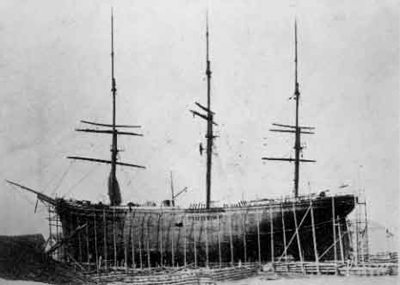
Credit: The Ship William D. Lawrence
Lawrence House, 67.304.37, N-20663
On October 27, 1874, the largest wooden-hulled ship built in Canada was launched at Maitland, Nova Scotia. Named after her builder and owner, William D. Lawrence, she was 2,459 tons with a keel length of 244 feet 9 inches. One of the most intriguing questions about this vessel is why William D. Lawrence, a well-established and highly respected shipbuilder and shipowner, would risk all his wealth and considerable reputation to build a vessel so large that many of his contemporaries openly described it as folly.
In response to one of his critics, Lawrence claimed that one large ship would be more profitable than two smaller ones.1
Lawrence was not merely content to build a large vessel: he intended to build "the largest vessel ever placed upon the stocks in the Dominion or in British North America"; moreover, he stated his objective publicly in the Acadian Recorder of February 21, 1873.2 It seems clear that Lawrence wished to give himself and Nova Scotia a permanent place in the marine history of Canada. His reasons for doing so have a great deal to do with the man himself and the era in which he lived.
Compared to many other maritime shipowners of the mid-19th century, Lawrence's efforts were rather modest. Beginning with the successful operation of his first vessel, the 170-ton brigantine St. Lawrence, built in 1852, he owned, usually in partnership with other investors, a total of five vessels during the next twenty years. Often one vessel was sold to pay for a new one. His commercial success sprang from his ability to manage his vessels in a very competitive business fraught with periodic declines in freight rates.
The period between 1840 and 1880 was one of unprecedented commercial prosperity in Nova Scotia and in the Maritime Provinces generally. Spurred by the expansion in world trade, shipping tonnage owned in the Province increased from 80,000 tons in 1830 to 400,000 tons in the late 1860s.3 The profits from shipowning and the closely related shipbuilding industry contributed significantly to the Nova Scotian economy.

Credit: The Man William D. Lawrence
MMA, MP400.87.1, N-1024
"There is a great industry in this country that we would be poor without, and that is our shipbuilding. This building and owning of ships certainly is of the highest importance to a commercial navigating people, as a means of bringing wealth to a country. The shipping industry of Nova Scotia has made its way by its own enterprise and by its own vigorous exertions..." 4
Nova Scotian enterprise helped to establish Canada in the 1860s as the world's fourth largest shipping nation. As a spectator and participant in this achievement Lawrence held very strong views on Nova Scotia's contribution and its place in the marine affairs of the world. Lawrence took an understandable pride in the accomplishments of his fellow shipowners.
"Gentlemen, I love Nova Scotia...I desire to see her cities grow, her commerce extend, her ports crowded with shipping and manned with the sons of our own soil, many of whom I am proud to say are, at the moment, spreading canvas on every sea, from the cold north to the sunny south and conducting our ships to the ports of the most enlightened and commercial nations of the globe." 5
This strong sense of place, pride in entrepreneurial accomplishments and independent spirit were galvanized in Lawrence's mind by the single most important event of the time - Confederation. A member of the House of Assembly from 1863, he became a close political ally of Joseph Howe and, as such, a staunch and vocal opponent of Confederation. His opposition was linked inextricably to the negative effects Confederation would have on shipping interests in Nova Scotia. He claimed the surplus revenues in the Maritime Provinces, generated largely by profits from shipping, were to be used to pay the debts that Canada had accrued from building canals and railways. He was particularly incensed, after Confederation in 1867, when the Federal Government raised the tariff on imports from 10 to 15 percent, meaning higher prices for imported shipbuilding materials and a less competitive position for Nova Scotian shipbuilders building for export. Confederation was, he said, "an idle vision calculated to check the future growth and prosperity of our country." 6
In his political speeches and personal letters Lawrence's opposition frequently reached uncommon heights, referring to the proponents of Confederation as "traitors" and "enemies" of Nova Scotia.
Although Joseph Howe's move to the federal camp in 1869 stunned Lawrence, it did not lessen his resolve:
"You will find no deserter in me, I will stick to the course of the people and if I fall I will fall with the people." 7
In the midst of the rancorous Confederation debate, Lawrence began planning for the construction of the William D. Lawrence. His plans solidified in the summer of 1869 and he advised his son-in-law, James Ellis, master of the Pegasus, that he had "got the model finished for the new ship" with a 215-foot keel, considerably shorter than the one he was to launch in 1874. 8

Credit: Under construction at Maitland
MMA, MP1.71.3, N-3827
By the time the 245-foot keel of the William D. Lawrence was laid in the fall of 1872, Lawrence seemed determined to give Nova Scotia a distinction and a place in history that the Canadian Government could not take away. His motivation was the result of his own political fate and that of Nova Scotia. In 1871, after making Confederation a central issue in his campaign, he was defeated in the provincial election. For Lawrence, Confederation was a "fait accompli" and Nova Scotia could not rectify its "gross mistake".9 When his attention returned to the William D. Lawrence, he had carefully reviewed, as his scrapbook indicates, the sizes of the largest vessels built in Canada to that date, and built accordingly. Based on Lawrence's assertions, a reporter from the Acadian Recorder was able to proclaim Lawrence's intentions in the spring of 1873. Soon after her launching in October 1874, many newspaper reporters quickly endorsed Lawrence's claim to having launched the largest ship in Canada.10
Lawrence's decision to build the largest vessel was not taken lightly. Knowing the risks of building and operating such a vessel, Lawrence was undaunted. His pride in the vessel was evident from the outset. During her construction he defended her regularly against an "army of croakers" who dismissed her as too large to handle and a potential financial fiasco. He was a passenger on her maiden voyage around the world, and after he sold her in 1883 he publicly defended her against claims that she was a money loser. He proudly replied she had paid for herself in two or three years, and during her career cleared a considerable profit.11 Lawrence maintained pride in his achievements until his death in 1886. His obituary asserted: "The old gentleman was always pleased to hear any reference to the subject and his eyes kindled when, in company, the W.D. Lawrence was mentioned. He looked upon the vessel as the crowning achievement of his life. And it is one of which any native Nova Scotian shipbuilder might well feel proud." 12
Lawrence was undoubtedly an individual who relished a challenge. He stated in 1884: "All great results have been the result of years of anxious thought and care... There is nothing like a stiff opposition to make a man succeed in business. Kites rise against, not with the wind." 13
It was this independent spirit which induced Lawrence to attain the distinction he desired for himself and his province.
Footnotes
1. The Nova Scotian (Halifax) January 12, 1884.
2. Acadian Recorder (Halifax) February 21, 1873.
3. Ships and Shipbuilding in the North Atlantic Region. Keith Matthews and Gerald Panting, ed. (St. John's; Memorial University of Newfoundland, 1978). Appendix l.
4. Speech on Nomination Day, 1878, in William D. Lawrence Scrapbook, 1867-1882. Dalhousie University Archives.
5. Speech on Nomination Day, 1867, in William D. Lawrence Scrapbook, 1867-1882. Dalhousie University Archives.
6. Speech on Nomination Day, 1867, in William D. Lawrence Scrapbook, 1867-1882. Dalhousie University Archives.
7. Letter to Isaac Sanford, February 20, 1869, in William D. Lawrence Letterbook 1867-74. Dalhousie University Archives.
8. Letter to Captain James Ellis, July 28, 1869, in William D. Lawrence Letterbook 1867-74. Dalhousie University Archives.
9. Speech on Nomination Day, 1878, in William D. Lawrence Letterbook 1867-74. Dalhousie University Archives.
10. Daily Reporter and Times (Halifax) October 29, 1874.
Daily Acadian Recorder (Halifax) October 28, 1874.
Daily Telegraph (Saint John) October 30, 1874.
11. The Nova Scotian (Halifax) January 12, 1884.
12. Obituary of William D. Lawrence, Shipbuilder, December 8, 1886, in William D. Lawrence Scrapbook. Dalhousie University Archives.
13. The Nova Scotian (Halifax) January l2, 1884.
Written by Marven Moore.
Links
Lawrence House - the restored home of her builder, now part of the Nova Scotia Museum
Frequently Asked Questions about William D. Lawrence